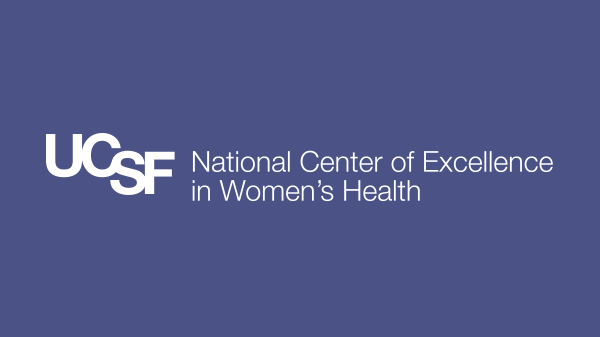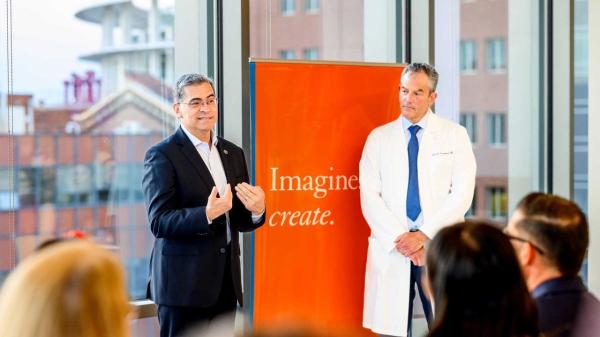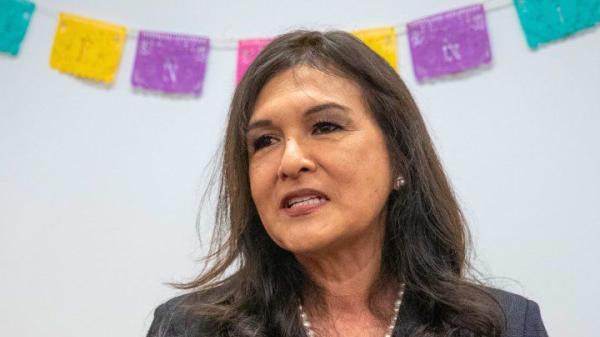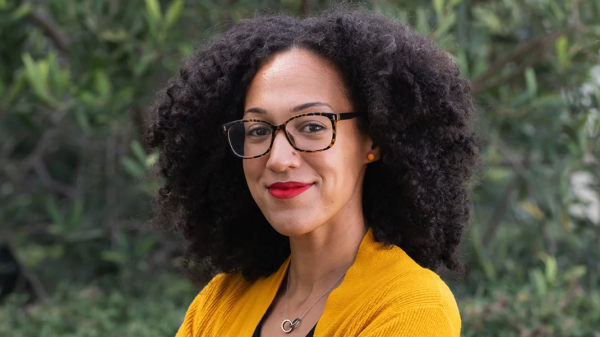Nadine Burke Harris Delivers Annual Chancellor’s Health Policy Lecture
By Rebecca Wolfson
nadine-burke-harris-health-policy-lecture-ucsf-.jpg
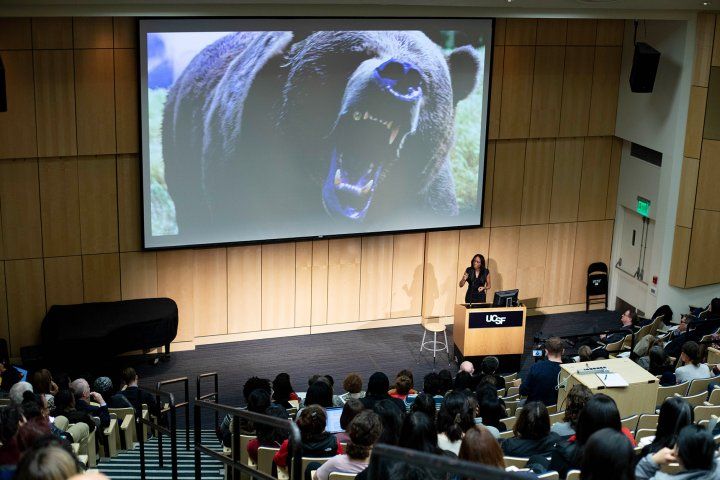
Nadine Burke Harris, MD, California’s first surgeon general, has a bold goal: cut adverse childhood experiences and toxic stress in half within one generation.
She spoke about her vision and her groundbreaking work to reduce adverse childhood experiences across the state during a speech at the UC San Francisco Parnassus Heights campus. The lecture at Cole Hall on Feb. 13 was part of Chancellor Sam Hawgood’s health policy series, organized by the Philip R. Lee Institute for Health Policy Studies.
Hawgood introduced Burke Harris and emphasized UCSF’s values related to health equity.
“It gives me great optimism that the contributions of all of you have a profound impact on health disparities amongst the most vulnerable populations we serve,” Hawgood said.
Hawgood promised to support Burke Harris’ mission to reduce the prevalence of toxic stress in the state. “We pledge to do everything we can to make your tenure as the first surgeon general of California a roaring success.”
Burke Harris was appointed by California Gov. Gavin Newsom, who created her role to address the root causes of some of the most severe, intractable and expensive health challenges facing California.
Adverse Childhood Experiences (ACEs) are 10 criteria that can occur before age 18 and include physical and emotional abuse, neglect, substance abuse, caregiver mental illness and household violence. In California, 63.5 percent of people have experienced at least one ACE and 17.6 percent have experienced four or more ACEs. ACEs dramatically increase nine out of the 10 leading causes of death in the United States, and are estimated to cost California on average $113 billion per year, which will add up to a trillion dollars over the next decade.
“We have no other option but to tackle this issue head on,” Burke Harris said.
But, ACEs are not destiny, Burke Harris said. “With early detection and evidence-based interventions we can transform health outcomes.”
Burke Harris looks to other public health victories as models for how to address this issue. HIV, for example, went from a 50 percent mortality rate within six months of a diagnosis to a life expectancy of greater than 50 years after diagnosis. By implementing clinical protocols tracking and addressing major drivers of maternal mortality, California reduced maternal mortality rates by 50 percent between 2006 and 2013.
How Stress Can Become Toxic
ACEs, Burke Harris said, are harmful because of the toxic stress response in the body – she used an encounter with a grizzly bear as an example to demonstrate the toxic stress response’s effect.
If someone walks in the forest and sees a grizzly bear, their amygdala sounds the alarm and activates the release of stress hormones and cortisol. Their heart pounds, and their nervous system shunts blood to their skeletal muscles for running and jumping so they’re ready to run or fight the bear. Their amygdala also sends projections to the pre-frontal cortex that’s responsible for judgement to ensure that impulse control doesn’t get in the way. Their immune response is activated to reduce inflammation in the case of an injury.
While this response can be life-saving during a potential bear attack, it can become maladaptive in children who are exposed to chronic violence, abuse, or neglect. Children are especially vulnerable to this stress response because their brains and immune systems are still developing, Burke Harris said.
The impact of ACEs can seep into adulthood. For example, women who become pregnant who had high ACEs have increased risk of prenatal and perinatal problems, and their offspring also have increased risk of adverse health issues.
“We know we can use science to break the cycle,” Burke Harris said. “Just as our bodies evolved to save our lives form a mortal threat, our bodies also evolved physiological mechanisms to counterbalance the stress response.”
The buffering effect of a caring adult, Burke Harris said, can prevent the stress response from becoming toxic. For example, showing children love and affection after something scary happens to them, releases oxytocin, protects against induced cell death, and protects vascular endothelium. “Our bodies are wired to have these healing and protective mechanisms,” Burke Harris said.
“My goal is to cut ACEs and toxic stress in half in one generation,” Burke Harris said. “I know that sounds ambitious, but I’m here to go big or go home.”
Under Burke Harris’ leadership, California became the first state in the nation this year to reimburse health care providers for screening Medi-Cal patients for ACEs. The tool selected to screen for ACEs in California is the Pediatric ACEs and Related Life-Events Screener (PEARLs), which was developed by pediatricians and researchers from UCSF Benioff Children’s Hospital Oakland, the UCSF School of Medicine and the Center for Youth Wellness (CYW). PEARLS is available to 8,800 clinics and almost 100,000 physicians, and could improve the health of 7 million children on Medi-Cal.
While screening is just one step, it is an important one. And UCSF researchers and thought leaders are working on what comes next.
Statewide Learning and Quality Collaborative
In January, the UCSF Center to Advance Trauma-informed Healthcare (CTHC) signed a $10.7 million contract with the California Office of the Surgeon General and the Department of Health Care Services to lead a learning and quality collaborative to disseminate best practices and tools to help providers treat ACEs.
The UCSF California ACEs Learning and Quality Improvement Collaborative (CALQIC), led by UCSF co-directors Anda Kuo, MD, Marguerita Lightfoot, PhD, and Edward Machtinger, MD, is an 18-month statewide learning collaborative of pediatric and adult clinics in five California regions that will include onsite and virtual coaching (content and process); expert training and peer-to-peer sharing of promising approaches, challenges and solutions; site visits to successful programs; and funding support.
The learning collaborative will ensure that lessons learned are methodically collected and analyzed as providers deploy ACEs screening and responses, Machtinger said. This iterative process will allow learnings to inform trainings in CALQIC and develop best practices and tools that will support the next phases of the statewide training initiative.
“After over two decades of treating patients, our experience taught us an undeniable truth: the massive U.S. health care system essentially ignores our leading cause of illness, death and disability – trauma,” Machtinger said. He co-led the national working group to define and demonstrate the components of trauma-informed health care and is considered a national leader in the emerging field of trauma-informed health care.
Kuo, a professor in the Department of Pediatrics, and the Academy Chair for Pediatric Education for the Haile T. Debas Academy of Medical Educators, said all providers should be trained in ACEs and trauma. “How do you care for patients and work with a care coordination team to address these issues?” Kuo said trauma-informed curriculum and training should bring in the expertise of patients in the community.
Changes to the School of Medicine Curriculum
Curriculum leaders in the UCSF School of Medicine are looking at ways to continue to incorporate this topic into the Bridges Curriculum so that future physicians are prepared to screen for, and address, ACEs in their patient populations.
“It is incredibly important that we all understand what ACEs are and how they impact the burden and manifestation of diseases we commonly see,” said School of Medicine Associate Dean for Curriculum John A. Davis, MD, PhD. “Our curriculum is committed to imparting that understanding to the next generation of physicians.”
Currently, ACEs are incorporated into the curriculum during student’s first year and during optional sessions in the second year. In a first-year course broken up into two parts, “Health and Society,” and “Health and the Individual,” students learn about how childhood experiences affect peoples’ ability to cope with stresses in the future.
“The origins of ACEs curriculum is rooted in the understanding that stress and trauma affects health care and health outcomes,” said Megha Garg, MD, MPH, who is a hospitalist at the UCSF-affiliated San Francisco VA Medical Center and is also the course director for “Health and Society” and “Health and the Individual.”
Medical students, Garg said, should have an awareness of the connections between ACEs and health. Physicians should know how to engage in conversations with patients about ACEs, talk to them in a supportive way, and understand what resources and interprofessional team members are available to support patients.
“I think we’re realizing that [understanding and addressing ACEs] is the future of medicine,” Garg said. “It is an essential competency for future physicians.”
Leigh Kimberg, MD, a professor of Medicine, the director of the Program in Medical Education for the Urban Underserved (PRIME-US) and a participant in the CALQIC initiative, said all health care professions students need to be equipped with foundational knowledge about how to care for patients and themselves in a ‘healing-centered and trauma-informed way’.
Equity and anti-oppression pedagogy should be critical elements of addressing ACEs in medical education, Kimberg said. “Students should graduate with knowledge about how trauma, which ruptures relationships, and resilience, built through safe, stable, nurturing relationships, affect health and well-being,” Kimberg said. To reduce ACEs, Kimberg said the medical community must partner with other sectors in society to address the root causes of childhood trauma by promoting safe, stable, nurturing relationships through equity in access to important resources like high quality childcare, education, and health care for all children and caregivers.

